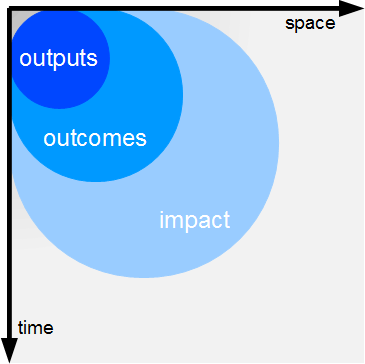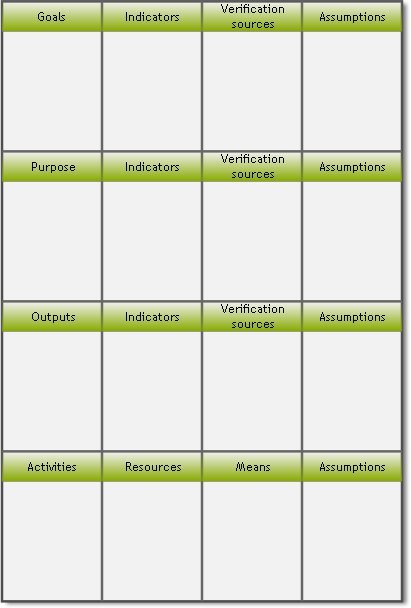Deciding on the intervention logic (project logic)
The intervention logic is the cause-and-effect chain or results chain that’s been identified in the Performance Framework:
- You gather the necessary resources (human resources, materials, equipment) and funds
- With the resources, you can organise the activities
- The activities produce outputs: goods, services, knowledge, information, etc. These are the immediate results.
- When these outputs are used, they lead to effects or intermediate results.
- The effects contribute to the final results, or impact.
This information is presented in the logical framework (first column, except for the resources).
Note that compared to the ‘classic’ logical framework as it is used in LFA and PCM, there is a dimension of time in the intervention logic of RBM, as well as a spatial dimension. We immediately get the outputs as a consequence of the activities. But it takes time for the effects to materialise (near the end of the project or maybe even after it) and the impact will only be visible after a long time (sometimes years or even decades after the project). The outputs will be used directly by the people involved in the project, while the effects are generally felt by those people and their immediate surroundings (family, clan, village). The impact on the other hand may be visible in a widespread area (region, country, internationally).

Step 7: Developing the logical framework

Now it’s time to bring together all the information that you’ve gathered so far into the logical framework matrix:
- The first (left) column contains the intervention logic.
- The second column contains the indicators
- The third column contains the verification sources
- The fourth column contains the assumptions/risks.

Once you’ve filled out the basic ideas, it’s time to worry about formulation. Make sure that your results are clear and not too overly complex. It’s important that they are unambiguous – meaning that they are understood the same way by everyone involved in the project. Avoid overly complex concepts such as ‘gender neutral’, ‘globalisation’, ‘sustainable’ that can be interpreted in many different ways. If you need such concepts, make sure that you specify them in your logframe and/or explain them somewhere.
It’s best to make sure that your results are formulated in a SMART way:
- Specific: What exactly will change? Where? For whom (who will benefit)?
- Measurable: How much will it change? You have to set a target.
- Attainable: make sure that you don’t make unrealistic expectations about the change that you can achieve through your actions.
- Realistic, in the sense of based on a real world situation: make sure that what you propose is coherent and pertinent for the problems that your beneficiaries face.
- Time specific: indicate the timeframe in which the change will take place. Outputs have to be realised within the timeframe of the project. Effects may occur near the end or right after the end of the project. Impact is generally only visible well after the project.
Outputs can be things or services, but at least on the level of the intermediate results (the purpose of your project or the specific objective in PCM/LFA talk) talk about results in terms of people. You are trying to improve the lives of your beneficiaries (clients), not some kind of abstract change of situation.
Step 8: Writing the project proposal

The logical framework and the other tools such as the budget, the PMF and the risk register provide you with the basic information for the project proposal document. Generally, the narrative project document contains information about:
- Introduction of the organisation
- Identification
- History
- (Strategic) objectives of the organisation
- Summary of the project
- Detailed description of the project:
- Title and location
- What the situation is of the target groups in the area of intervention/country;
- Who the partners are;
- What the objectives are;
- Description of how the objectives, target groups and partners were identified (explaining this was done one a participatory basis).
- How the objectives fit in the donor’s policy/the country development strategy;
- What activities will be executed;
- What resources are needed (overview of main costs, with detailed budget in annex)
- How the activities and results will be monitored and evaluated
- What the risks are and how they will be dealt with;
- How the partners will collaborate with local authorities and other stakeholders
This narrative project document is completed with a number of annexes:
- The budget proposal, detailing every expense and sometimes regrouping them per activity or output
- The logical framework of the project
- A detailed planning of the activities
- Other documents to explain how the organisation manages its projects, such as partner identification forms, registration forms for beneficiaries and target groups, the official NGO registration and so on.
In the concept of RBM, the partners should be closely involved in the elaboration of the project proposal. This means that they participate in the writing but also that they officially approve the end result. Following this process of internal review and approval, the proposal is sent to one or more donors.